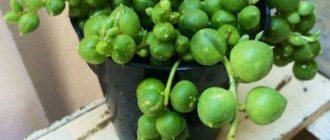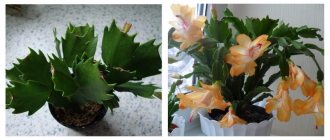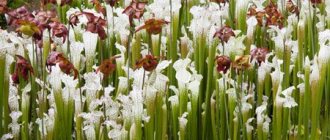Regardless of the method of propagation, flowering of streptocarpus at home begins no later than 10-11 months. The plant does not have a central stem; its oblong, slightly fleecy leaves are collected in a wide rosette. The leaf shape is elongated, lanceolate. The name of the plant is associated with the shape of the seed pod.
| Growing quickly. Blooms in the year of planting. |
| Blooms from late spring to early autumn. |
| The plant is easy to grow. |
| 2-3 years. Then the plant loses its attractive appearance. |
Useful properties of streptocarpus
Streptocarpus is grown for decorative purposes. It looks good in any interior, not only during the period of abundant flowering. The rosette of young leaves also looks impressive. The plant is not toxic, but it also has few beneficial properties. Some fans use it in small quantities as a spicy seasoning.
Power Requirements
A young bush that grows quickly after reproduction requires nitrogen fertilizing. But they should be reduced in percentage terms when buds appear. Now streptocarpus needs phosphorus and potassium. Of the ready-made compositions for indoor plants, the “New Ideal” fertilizer is first used; later, fertilizers for beautifully flowering plants of the “Super Flowering”, “Violet” and similar series are suitable. Fertilize the plant once a week, alternating different formulations. During the dormant period, no feeding is done.
It is better to reduce the recommended doses of fertilizer by half. If during this period the plant actively grows leaves, this is normal. A peduncle will appear from the axil of each leaf. Therefore, the lower leaves, whose peduncle has already faded, must be removed by carefully cutting them off with a sharp knife. Watch the video on how to care for streptocarpus and grow a spectacular bush.
Caring for streptocarpus at home. Briefly
In order for the plant to develop well and bloom profusely, it is necessary to create acceptable conditions for it:
| Temperature | Streptocarpus at home reacts negatively to temperatures above 25°C and below 14°C. |
| Air humidity | Requires maintaining high humidity in the room without wetting the surface of leaves and flowers. |
| Lighting | Prefers good lighting without prolonged exposure to direct sunlight and long daylight hours. |
| Watering | Regular moderate watering of the soil at the root without waterlogging is required. |
| Priming | The plant prefers light, loose, nutrient-rich soil with good drainage properties. |
| Feeding and fertilizer | During the period of intensive growth and flowering, it is necessary to replenish nutrients at least 2-3 times a month. |
| Transfer | In order to rejuvenate the bush, maintain soil volume and its quality, replanting is carried out at least once a year. |
| Reproduction | Conducted by seeds and vegetative organs. |
| Features of cultivation | Requires bright, moderately warm, humid rooms with ventilation, but without drafts, combustion products and tobacco smoke. |
Transfer
Streptocarpus, primarily due to its gluttony, are very fond of transplantation. There is even a joke among collectors that if streptocarpus is capricious, all you need to do is replant it - it works. At least once a year, and preferably twice, in spring and late summer, transshipment is carried out with partial replacement of the soil.
Choosing the right pot and soil
Pots for streptocarpus are chosen low and wide. Young plants are planted in containers with a diameter of 8 cm; with each replanting, the size is increased by 2 cm up to 12 cm. It is not practical to keep streptocarpus in larger containers, so in the future, transshipment is replaced by rejuvenation.
The optimal soil for streptocarpus consists of equal parts of low-lying peat and leaf soil. Peat is often replaced with coconut fiber. To improve moisture exchange, perlite and sand are added to the mixture. Many sources advise adding chopped moss, but streptocarpus prefer to grow in neutral soil, and moss acidifies it. It is better to spread sphagnum on the surface to increase humidity around the bush.
Step-by-step transplant process
Planting streptocarpus in a new pot looks like this:
- A layer of expanded clay or finely chopped foam is placed at the bottom of the container.
- Fill the soil, water it abundantly, and make a planting hole.
- The bush is carefully removed from the old pot.
- The earthen ball is partially shaken off and placed in the planting hole, so that the bush does not have to be buried and so that its base is not exposed.
- If necessary, add substrate to the sides, lightly press down and water again.
- After transshipment, the plant is placed in a ventilated greenhouse for 5-7 days.
Rejuvenation is carried out according to the same scheme with a slight difference:
- Part of the root system (about 1/3) is cut off. This is convenient to do with scissors.
- Damaged and yellowed lower leaves are removed.
- The bush is buried a little so that part of the trunk, exposed after removing the leaves, is underground.
The volume of the pot is not increased during rejuvenation, but it is still better to take a new container, or thoroughly wash and boil the old one.
Caring for streptocarpus at home. Details
The opinions of flower growers regarding the whimsical nature of the plant do not coincide. Some consider its cultivation a simple matter, accessible even to beginners. But in order for a flower to really please with its appearance and beautiful flowering, you need to create certain conditions for it and constantly pay attention.
Streptocarpus flowering
The plant has many varieties and hybrids, differing in the shape of the flowers and their color, from white to purple, with various inclusions and stains.
A combination of several colors is possible. The flowers are shaped like tubular bells. The smaller they are, the more inflorescences are formed and the more abundant the flowering. One peduncle emerges from the leaf axil, on which, depending on the variety, can bloom from several flowers to several dozen. The size of the flower corolla in some varieties reaches 8-10 cm. As a result of flowering, a seed capsule containing many small seeds is formed. Streptocarpus flower is rarely grown for seeds at home.
Attention! To ensure that the plant has an attractive appearance and does not become depleted, fading inflorescences are cut off without waiting for the capsule to form.
Temperature
The flower reacts poorly to high temperatures, despite its African origin. It is comfortable at a temperature of 20 to 25 °C on a windowsill or balcony protected from direct sunlight. The minimum permissible air temperature in winter is 14-15° C.
Spraying
Dry indoor air negatively affects the condition of leaves and flowering, so it is necessary to use a humidifier or spray the air with a spray bottle.
When water gets on the leaves and flowers, streptocarpus loses its attractive appearance, so care at home is carried out by wiping the leaves with dry wipes. Pallets with wet expanded clay, pebbles, and moss, which are installed in close proximity to the pots, are also used as humidifiers.
Lighting
For full flowering, the plant requires a lot of light and long days. But the sunlight must be diffused so that the leaves do not get burned. On the north side of the house, lighting may be insufficient and additional lighting will be required with lamps. Western and eastern window sills are best suited for growing.
Watering
Domestic streptocarpus requires regular, moderate watering with well-settled warm water.
Excessive moisture leads to rotting and even death of the plant, so it is better to water less than overwater. In summer, the frequency of watering is 2 times a week, in winter - no more than every 8-10 days. At low air temperatures (15 °C and below), watering is stopped completely.
Soil for streptocarpus
The plant prefers light, loose, fertile soils with good air exchange. The easiest way is to buy ready-made balanced soil in a specialized store. You can prepare the mixture yourself in the following proportions:
- leaf soil - 2 parts;
- peat, sand, humus - 1 part each.
You can also mix equal parts of soil, peat and sphagnum moss. A mixture of peat, perlite and humus (5:2:1) is suitable for raising children.
Drainage materials must be poured onto the bottom of the pot.
Attention! All components of the mixtures, drainage and growing containers are disinfected by heating or a solution of potassium permanganate.
Feeding and fertilizer
Streptocarpus develops intensively and requires a lot of nutrients. At the initial stage, for the growth of a rosette of leaves, preference is given to nitrogen fertilizers; at the stage of laying flower stalks and during the flowering period, preference is given to phosphorus-potassium fertilizers.
Specialized stores offer complex preparations that are easiest to use. Fertilizing is combined with watering at intervals of 8-10 days and is carried out only in the spring and summer.
Pot size
When growing a flower by sowing seeds, seedlings in the phase of 2 true leaves are planted into free containers at a distance of 1.5-3.0 cm, and then the grown plants are transplanted into separate pots. Their size at the initial stage is 6-8 cm.
With each transplant, the pot is increased by a couple of centimeters. When grown in a container that is too large, increased growth of the rosette of leaves is observed and flowering slows down. For an adult plant, the volume of the pot should be at least 16 - 18 cm, shallow, since the root system is located superficially.
It is better to grow a flower in a ceramic pot, but it also feels good in a plastic one if there is drainage and proper watering.
Transplantation of streptocarpus
Streptocarpus can grow in one place for quite a long time, but by the 3rd year of life the rosette of leaves thickens, the plant becomes depleted, looks less attractive, blooms poorly, and loses its decorative effect.
Transplantation solves several problems:
- bush rejuvenation;
- reproduction;
- increasing the volume and quality of soil.
Rest period
Only mature, healthy specimens can bloom throughout the year, although without a rest break their appearance and flowering quality deteriorate. In winter, conditions for a dormant period are artificially created by reducing watering, lighting, stopping fertilizing and lowering the air temperature.
Trimming
For sanitary purposes, damaged and yellowed leaves and fading flower stalks are pruned. From adult bushes, small shoots that are not able to compete with developed vegetative organs are removed.
Streptocarpus - description, belonging to the family
The Streptocarpus flower was first discovered in 1818 in the mountains of South Africa. Its name is a combination of two Greek words: streptos - curled and karpos - fruit. The bush was named so for a reason. The fact is that its seeds during the ripening period have the shape of a box. It is characterized by large leaf blades and long peduncles on which buds of a blue or purple hue are located.
Streptocarpus (appearance)
Additional Information! Streptocarpus is native to the Cape Province of South Africa. Therefore, it is often called Cape primrose.
Currently, almost 150 species of wild Cape primrose are known. Some of them grow on rocky surfaces, others on trees. Depending on the variety, flowers can grow in the shade or in sunny meadows. They can be either annuals or perennials. But they all have one thing in common - they belong to the Gesneriev family.
Domestic varieties are usually not large in size - they rarely reach a height of more than 40 cm, and peduncles grow no more than 25 cm. The leaves of the flower are quite large - 30 cm in length and up to 7 cm in width.
Blooming buds, in addition to the standard colors, can have different shades:
- red,
- purple,
- pink,
- yellow,
- black,
- with stripes,
- speckled,
- with patterns.
This is interesting! Another distinctive feature of Streptocarpus is the fruit, which has a spiral shape.
Reproduction of streptocarpus
Various methods are used to propagate the variety. Vegetative methods make it possible to completely preserve the characteristic characteristics of the mother plant. Growing streptocarpus through sowing seeds is a rather lengthy process and the result cannot always be predicted.
Reproduction of streptocarpus by dividing the bush
Along with replanting in the spring, the plant is also propagated by dividing an adult bush (2-3 years old) into parts.
- The roots are freed from the soil, carefully untangled, separated by hand or using a sharp sterile knife.
- Damaged parts of the root are removed, and the cut areas are sprinkled with activated carbon.
- To create a new rosette, young shoots (babies) with good roots are selected and planted in moist, loose soil.
- To retain moisture until establishment, new plants are kept under a transparent cover in diffuse sunlight.
Propagation of streptocarpus by cuttings
Streptocarpus can also be propagated by other vegetative parts of the plant: children left from division without roots, whole leaves with petioles and their parts.
- They are immersed to a shallow depth in water until roots form, in moist soil or moss.
- The cutting areas are treated as when dividing a bush.
- After the roots appear, the cuttings are transplanted into a pot with the selected substrate.
Growing streptocarpus from seeds
Most often carried out during breeding work to obtain unique characteristics.
- Streptocarpus flowers are sown at home in shallow containers filled with vermiculite, peat and perlite.
- To ensure that small seeds are evenly distributed over the surface, they are mixed with sand.
- After sowing, moisten the soil with a spray bottle.
- To retain moisture and create a greenhouse effect, the container is covered with glass or transparent film.
- Before seed germination, maintain a temperature of 22 - 25 °C, carry out regular ventilation and remove condensate. Under favorable conditions, seedlings will appear in 10-14 days.
- The shelter is removed, but high humidity continues to be maintained.
Toaster propagation method
- For this method, leaves are used, from which the central vein is cut out.
- The sections are treated with charcoal, dried and buried into the soil by about 5 mm.
- If optimal humidity is maintained, after 1.5 months small children will sprout, which at the age of 3-4 months are transplanted into pots.
Popular varieties and varieties
The Streptocarpus genus is extensive and includes more than 130 species, most of which perfectly adapt to indoor conditions:
- Streptocarpus rocky is a drought- and bright-light-resistant inhabitant of mountain slopes. The leaves are small, light green, oval; lilac flowers.
- Rex - elongated lanceolate leaves with pronounced pubescence. Settles in forests, accordingly, prefers humidity and partial shade.
- Streptocarpus Wendland is an exotic annual species that produces only one leaf. After flowering it dies.
- Hybrid streptocarpus is a group of varieties that appeared as a result of breeding work. Hybrids with similar characteristics are often combined into series, for example, Madagascar, Volna.
Until recently, about 15 years ago, plants from the last group were monochromatic, sometimes with darker strokes or a light throat. Today, there are many incredible contrasting colors of hybrid streptocarpus. This became possible thanks to a successful coincidence of circumstances, a spontaneous mutation that occurred in the collection of the Danish breeder Bant Nilsson and gave the world the “Silvia” variety.
The upper and lower petals of the mutated plant were colored in two genetically independent colors, purple and yellow. At the same time, the inherent strokes on the yellow field and the lighter throat were preserved. Another feature of Sylvia is the wavy, contracted shape of the lower petals. The bicolor was preserved by descendants, but in different color combinations. And the rare shape of the petals made possible the appearance of fringed, frilly and double flowers.
This is how popular hybrids appeared:
- Black Swan - large frilly dark purple flowers.
- Wow – raspberry top, yellow bottom.
- Mozart - the upper petals are painted blue, the lower petals are creamy yellow, with a mesh.
- Draco is the incomparable work of breeder Piotr Kleszczyński. The upper petals are pale pink, fringed; the lower ones are yellow with a bright dark burgundy mesh. The pharynx is yellow, with diverging brown rays.
- Crystal lace - bluish-white fringed petals covered with an elegant purple pattern.
- Dymok is a terry variety with a pale blue “top” and a white “bottom”, along which dark blue rays spread.
- Listy is a pink-orange hybrid adorned with darker mesh.
Modern streptocarpus with their rich, bright colors will not leave anyone indifferent.
Diseases and pests
Under favorable growing conditions, streptocarpus resists various diseases quite well. If a plant has problems, it will immediately react with its appearance:
- Streptocarpus leaves wither and curl from lack of moisture or excess sunlight;
- yellow streptocarpus may appear due to sunburn;
- dried tips of streptocarpus leaves and their blanching appear from a lack of moisture and mineral nutrition;
- does not grow and does not produce young leaves if there is insufficient lighting, depleted soil or inappropriate pot size;
- Streptocarpus roots rot due to excessive watering, low temperatures and drafts.
The development of fungal and bacterial diseases most often results from a violation of the temperature regime due to excessive watering and contact of vegetative organs with water. When the first symptoms of the disease appear, it is necessary to:
- removal of damaged areas;
- spraying with a fungicide or a solution of laundry soap;
- change in conditions of detention.
Watering and humidification mode
Growing and caring for healthy streptocarpus involves proper plant hydration. Watering through the drainage hole is considered normal. It is good to organize moistening of the earth through a wick. In this case, the constant supply of capillary moisture keeps the soil consistently moist. When top watering, water should be poured over the walls of the pots, trying not to get on the leaves and flowers.
Water streptocarpus with soft warm water. If the plant has dropped its leaves due to the drying out of the soil, its elasticity will be restored, but the drooping flowers will have to be cut off; they are lost.
Streptocarpus loves spraying with a spray in the form of a mist, but droplets of water on the leaves can lead to the appearance of unsightly spots. For humidity, it is appropriate to keep the flower pot on a tray with a humidifier. A saucer of water placed near the plant will also help.
Pests
Insufficient air humidity and high temperature create favorable conditions for the spread of:
- Thrips, aphids, spider mites. They feed on the sap of the plant and damage the leaves, on which silver, yellow, white or transparent spots appear. The plant sheds its leaves. The growth of streptocarpus slows down or stops completely. Damaged buds fall off without blooming.
- The mealybug destroys young shoots and buds. Can lead to a complete stop in plant development.
- The scale is located mainly on the lower part of the leaves and on the petioles in the form of brown warts covered with a waxy coating. A colony of these pests can completely destroy a plant.
In order to destroy pests, plants and soil are sprayed with insecticidal preparations (2-3 times). In difficult situations, replanting with soil replacement may be necessary. It is especially difficult to destroy scale insects, since their protective layer prevents contact with chemicals. They are removed manually with a damp cloth and then sprayed with systemic herbicides.
General information
Streptocarpus is one of the representatives of the extensive Gesneriaceae family. Its name translated from Greek means “twisted fruit” - during the ripening process, the testes twist into a spiral. A herbaceous perennial from tropical Africa came to us. In nature, it settles on mountain slopes, in relatively cool areas without sudden temperature changes.
The leaves are soft, wrinkled, elongated-lanceolate; collected in a basal rosette. Their number and size depend on the variety - there are plants that produce only 1 leaf during their life, such as Wendland streptocarpus.
Peduncles are elongated, formed on petioles. Unlike the violet, in which each leaf produces only 1 peduncle, streptocarpus can form up to 6 of them; an adult bush can expel more than 50 flower stalks at the same time. Each is “crowned” with one, less often 2-3, buds. The streptocarpus flower looks like a large bell; The color is bright, often with contrasting strokes and spots, and can be two or three colors.
Video: charming varieties of streptocarpus
Modern streptocarpus hybrids are real works of art. The color range of the new varieties is impressive: purple, snow-white, pink, dark blue, lilac, lavender and almost black flowers, decorated with streaks, dots, streaks and a mesh of veins. This plant will certainly decorate any home.
- Author: Olga Isakina
I am interested in many things. Handicrafts, gardening, floriculture and cooking are just a few of my hobbies. I am constantly discovering something new and learning something interesting. I am ready to share all my knowledge with my readers. Rate this article:
- 5
- 4
- 3
- 2
- 1
(5 votes, average: 3.8 out of 5)
Share with your friends!
How to plant streptocarpus grown from a leaf in a pot
After the appearance of young children, you need to wait until they grow up. They can be separated from the mother leaf when their length reaches 3 cm. They should be replanted in a different soil, more nutritious than for cuttings.
Read more Streptocarpus flowers: care and cultivation, video, photo, watering, fertilizing
Add peat, agroperlite, vermiculite, and chopped sphagnum moss to the soil. Add components in a ratio of 3:1:1:2:2. You can use soil for violets.
The video will tell you how to separate the children of streptocarpus propagated by leaves:
Reviews from flower growers
I only recently, this summer, started growing streptocarpus. I bought leaves and now little babies are growing out of them. I bought some plants as small children. Some stand and bloom on the loggia - they like the cool. Some are under the lamps on the window (the window is also always open to the loggia .The main thing is not to overwater, otherwise they are very unpretentious!
If they grow to flowering, they bloom constantly.
Deer https://forum.bestflowers.ru/t/streptokarpus-uxod-v-domashnix-uslovijax.109530/
Streps are beautiful, I fell in love with them at first sight, but when it came to the reproduction of existing children, I had to suffer.
But this probably makes me love them even more now)) For me it was problematic. In general, there are 3 options: propagation by seeds, dividing the bush and growing children from leaves. Nat31 https://irecommend.ru/content/zagadochnyi-tsvetok-streptokarpus-ukhod-i-razmnozhenie-strepsov-mnogo-mnogo-foto-moikh-lyubi
So I wouldn’t say that their flower is problem-free.
He is more demanding than many others. Well, watering is not difficult, it’s better to dry it out a little between waterings. Categorically does not like water getting on the leaves. Loves humid air, but, again, not too much. I'm not very painless with transplants. Transplanted plants take a long time to recover and get sick. Almost always, regardless of whether I divided the bush or replanted it entirely. Here you need to feel them. None of my other pets had such problems with transplantation (oh, no, there is also a silver peperomia, which is also very sensitive to transplantation - but with the rest everything is always ok) But even on a north window you can achieve flowering, and then it turns out so cheerful clearing: Natlli https://wap.romasha.forum24.ru/?1–18–0-00000011–000–0-0–1274589440
I grew my own streps from seeds.
(NK it seems, if necessary, I’ll look more precisely later). They germinate well and fairly quickly, but the seedlings are very small and weak and grow slowly. They categorically refuse to live without a greenhouse. They were finally removed from the greenhouse only 6–8 months after sowing. Picking noticeably accelerates the growth of young plants. They bloomed for me about a year and a half to two years after sowing. I also propagated them using cuttings using an “unconventional” method - I simply left them in a damp, hermetically sealed bag. Natali https://homeflowers.ru/yabbse/index.php?showtopic=3173
Description and varietal diversity
Streptocarpus is a genus belonging to the Gesnerieceae family. The genus includes at least 130 species of herbaceous terrestrial or epiphytic plants growing wild in tropical forests, on rocky mountain slopes, in fairly dry places or directly on trees. Representatives of Streptocarpus are distributed in the tropical regions of Madagascar, East Asia and South Africa. It was here in 1818 in the Cape Province that the botanist J. Bowie first found a plant with large leaves and bluish-purple flowers. Seeds for breeding were sent to the London Botanical Garden, where the “progenitors” of modern species and varieties were grown.
Streptocarpus are low rosette plants with a very shortened stem or without it. Large wrinkled and densely pubescent leaves have a broadly lanceolate shape. Tubular flowers with a well-developed limb, divided into 5 petals, several of them located on long peduncles, rising above the dark green leaves. The flower looks very much like a gramophone. An adult plant can bear from 80 to 100 flowers at a time. The fruits are seed pods that curl when ripe.
Streptocarpus rex is the oldest species in cultivation, which was used as a parent form for growing the first varieties.
Today, more than 1,000 varieties have been bred for home cultivation. Usually these are low (about 30 cm) plants with long 30-centimeter leaves 5-7 cm wide. 10 or more peduncles can grow from the axil of one leaf. The flowers of numerous interspecific hybrids are represented by almost the entire palette of shades from snow-white to almost black. There are streptocarpus that combine 2-3 colors of contrasting shades. Fancy specimens have flowers with intricate patterns. Single and double petals may have a corrugated surface, as well as wavy or rounded edges. Some varieties are distinguished by spectacular variegation. The sizes of flowers also vary from large, up to 5 cm long and with a bend diameter of 6-10 cm, to miniature. The smaller the size of the buds, the more of them are formed. Many small flowers form an airy cloud on the peduncle. Flowering occurs from early spring to late autumn. Moreover, if you provide proper care and additional lighting during the winter months, flowering will not stop.
Dimetris varieties grown by one of the leading streptocarpus breeders, Pavel Enikeev, are very popular. Hybrids are not demanding to care for, and the collections are incredibly diverse.
Possible problems
- Gray rot . If streptocarpus is watered excessively, it can be affected by gray rot.
- The buds turn brown . This happens when the room temperature is excessively high.
- The edges of the leaf blades turn brown . This can happen due to stagnation of liquid in the substrate or if the air humidity in the room is extremely low.
- Harmful insects . Most often, thrips, spider mites, scale insects, whiteflies and mealybugs settle on such a flower.
The leaves of STREPTOCARPUS are HINGING!! Causes!
Dividing a bush into parts when transplanting an adult plant
When the mother streptocarpus bush has grown too much and is already cramped in the pot, and thickened leaf rosettes cause a reduction in flowering, it is best to make several copies of new plants from your pet. To do this, remove the bush from the pot, carefully free its roots from the soil and cut the plant bush along with the root system of the flower into two or three parts with a sharp, clean tool (knife, blade). Make sure that each part has not only roots, but also leaves with a growing point. Sometimes five new young flowers are obtained from one overgrown bush at once. Treat each cut part with crushed charcoal or activated carbon. Prepare pots that are not deep, but spacious. Place 1 cm of expanded clay on the bottom. There is the same amount of land on it. Use the soil for decorative flowering indoor plants. Plant new bushes in pots up to the root collar, try to ensure that the soil fills all the voids in the pot and covers all the roots. Water the seedlings carefully along the walls of the pot with settled warm water. Place them in a bright place prepared for them (but not in the sun) under a film. The bushes quickly take root and soon begin to bloom.
How to preserve streptocarpus in winter
Typically, the plant goes dormant during the autumn-winter season. But this is an optional condition: with artificial lighting, it will continue to exist as usual .
If streptocarpus is in the dormant stage, you should lower the temperature and reduce watering. Do not place in a dark place, provide 7–8 hours of light.
At the end of February the flower will begin to become active. It can be transplanted into new soil, begin fertilizing in a month, and then follow the usual care rules.
Types of streptocarpus with photos and names
Streptocarpus candidus
This plant is a rosette plant, its wrinkled leaf plates reach about 15 centimeters in width and up to 45 centimeters in length. The flowering is lush. On the surface of white flowers, up to 25 mm in length, there are purple lines. There are purple stripes on the lower lip of the flower, and dots of the same shade in the throat.
Streptocarpus grandis
This plant has only one leaf blade, the width of which is about 0.3 m, and the length is up to 0.4 m. The height of the stem is about 50 cm, in its upper part grows a racemose inflorescence consisting of flowers with a pale purple corolla , and the pharynx is of a darker shade, the color of the lower lip is white.
Streptocarpus cyaneus
This plant is a rosette plant, its stem height is about 15 centimeters. Pink flowers grow on the stem, collected in bunches of 2 pieces. The center of the flower is yellow, while on the surface of the throat there are stripes and dots of purple color.
Streptocarpus wendlandii
This species is native to South Africa. The bush grows a single leaf plate, the length of which is up to 100 cm, and the width is slightly more than 50 cm; on its dark green surface there are veins of a paler shade. Five-centimeter flowers grow from the axils of a relatively long peduncle, the color of the corolla is dark purple, and there are white stripes on the surface of the pharynx.
Streptocarpus glandulosissimus
In nature, this species is found in the Ulugur and Uzambara mountains. The stem length is about 15 centimeters. The flowers can be colored in various shades from dark blue to purple.
Streptocarpus johannis
The stem of such a rosette plant is straight. The width of the leaf plates is about 10 centimeters, and their length is up to 50 centimeters. About 30 bluish-purple, almost twenty-millimeter flowers grow on the stem.
King Streptocarpus (Streptocarpus rexii)
This rosette plant is native to South Africa. There is pubescence on the surface of the elongated lanceolate leaf plates; their width is about 5 centimeters and their length is up to 25 centimeters. Axillary flowers can be single or collected in bunches of 2 pieces; the length of the funnel-shaped corolla is about 50 mm, and its diameter reaches about 25 mm. The color of the flowers is pale lavender, and there are purple stripes on the surface of the throat and corolla tube. This species is characterized by long and bright flowering.
Streptocarpus polyanthus
This single-leaf species comes from South Africa. The length of the densely pubescent leaf plate is about 0.3 m. Forty-millimeter pale blue flowers with a yellow center grow on high peduncles. The color of its throat is paler and somewhat similar to a keyhole.
Streptocarpus primulifolius
This rosette plant produces no more than 4 flowers. The color of the flowers varies from white to pale purple, and there are dots and stripes on their surface. The height of the stem is about 25 centimeters.
Streptocarpus saxorum
In nature, this plant is found in the mountains of the tropical zones in eastern Africa at an altitude of more than 1000 meters above sea level. The length of the hanging stems is about 50 cm. The foliage on the stem is located opposite. The bluish slightly downward-sloping flowers are similar to Saintpaulia flowers.
Description of the plant
The literal translation of the plant’s name is “twisted box.” It fully matches the appearance of the flower.
- flowers having one leafy stem;
- plants that do not have a stem (there is a rosette of leaves);
- flowers that have a leaf covered with hairs, the length of which is approximately 80 cm. Such bushes have well-developed peduncles.
- creation of two-color streptocarpus;
- creating fantasy, very unusual textural colors of petals forming a mesh;
- breeding double and semi-double streptocarpus;
- breeding miniature and variegated plants.
Growing and planting
To successfully grow and plant a plant, several conditions must be met:
- After purchasing, wait 14 days and only then replant the flower in a plastic pot;
- plant young shoots in shallow pots to obtain lush flowering and increase green mass - the more growth points the streptocarpus has, the more flower stalks there will be;
- young plants first grow green mass and then bloom, so the emerging flower stalks should be cut off;
- It is important to maintain the humidity and air temperature suitable for the plant, to provide the necessary amount of light and moisture.
Seating of streptocarpus babies:
- grown young shoots are separated from the mother plant and planted separately;
- there is no need to immediately plant the baby in a permanent flowerpot, as the plant will immediately begin to grow green mass and flowering will not occur;
- it is necessary to gradually move the streptocarpus from a smaller container to a larger one until the time comes for planting in a permanent pot.











